
lessons in chemistry recipes pdf
Discover free chemistry recipe PDFs with easy-to-follow lessons. Perfect for quick learning and experimenting at home!
Explore the fascinating intersection of cooking and chemistry with “Lessons in Chemistry Recipes PDF”․ This guide offers a scientific approach to recipes, blending experiments with culinary art․ Inspired by the Apple TV series, it provides detailed instructions for dishes like The Perfect Lasagna and A-Pie-ogenesis․ Perfect for home cooks and chemistry enthusiasts, it highlights how chemical principles shape cooking․ Discover how to turn experiments into delicious meals while learning safety tips and creative techniques․ A must-have for anyone curious about the chemistry behind food․
1․1 Overview of the Topic
The “Lessons in Chemistry Recipes PDF” explores the fusion of science and cooking, inspired by the Apple TV series․ It delves into how chemical principles shape culinary processes, offering a unique perspective on everyday recipes․ From The Perfect Lasagna to A-Pie-ogenesis, the guide provides detailed instructions and scientific insights․ It emphasizes experimentation, safety, and creativity, making it a valuable resource for both home cooks and chemistry enthusiasts․ By blending education with practicality, the PDF transforms cooking into a fun, interactive learning experience, highlighting the chemistry behind food preparation and its impact on taste and texture․
1․2 Importance of Chemistry in Cooking
Chemistry plays a vital role in cooking, as it transforms ingredients into flavorful dishes through chemical reactions․ Understanding principles like emulsification, Maillard reactions, and acid-base interactions enhances culinary skills․ The “Lessons in Chemistry Recipes PDF” highlights how chemistry explains cooking processes, such as browning meats or baking bread․ This knowledge allows for precise control over textures and tastes, ensuring consistent results․ By applying scientific concepts, home cooks and professional chefs can innovate and troubleshoot recipes effectively, making chemistry an indispensable tool in the kitchen․ This scientific approach fosters creativity and elevates cooking from art to a precise, understandable science․
1․3 Historical Development of Chemical Recipes
The concept of chemical recipes dates back to ancient alchemy, where scientists sought to transform materials․ Early civilizations documented cooking methods, blending chemistry with culinary art․ Over centuries, recipes evolved, incorporating scientific discoveries like emulsification and fermentation․ Historical texts, such as medieval recipe books, reveal how chemistry influenced food preparation․ The Industrial Revolution further advanced recipe development with standardized ingredients and techniques․ Today, “Lessons in Chemistry” bridges this historical gap, offering modern, science-driven recipes․ By exploring the past, we see how chemistry has always been the backbone of cooking, transforming simple ingredients into extraordinary dishes through chemical processes and innovations․
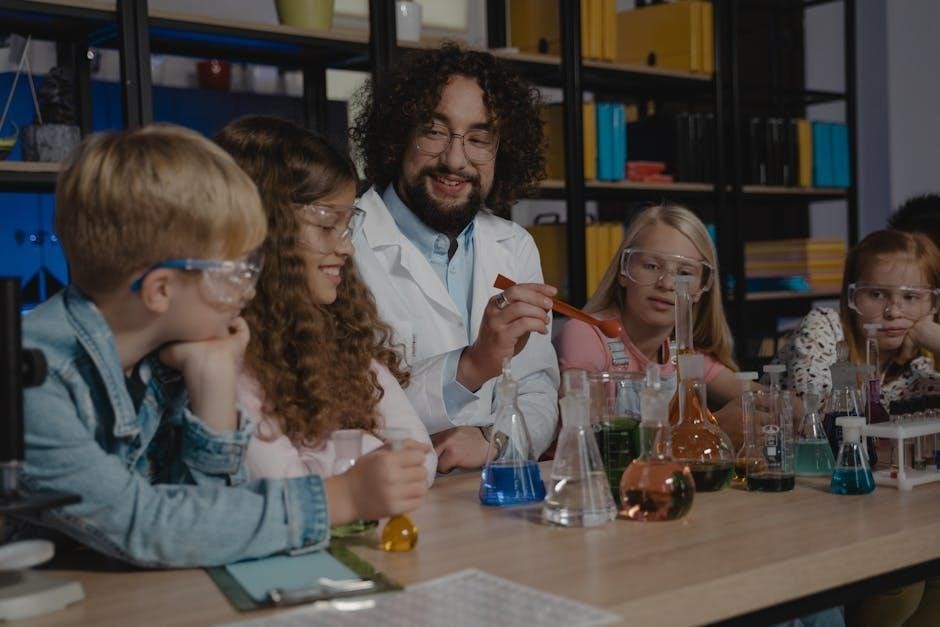
Famous Recipes from “Lessons in Chemistry”
Discover iconic dishes from “Lessons in Chemistry,” including The Perfect Lasagna and A-Pie-ogenesis․ These recipes, inspired by the Apple TV series, combine culinary art with scientific precision․
2․1 The Perfect Lasagna Recipe
Inspired by the Apple TV series, The Perfect Lasagna recipe from “Lessons in Chemistry” combines rich flavors with scientific precision․ It features layers of tender pasta, a hearty bolognese, and a creamy béchamel․ The recipe emphasizes precise measurements and techniques, such as emulsification in the bolognese, to ensure a harmonious balance of textures and tastes․ With detailed instructions, this dish exemplifies how chemistry enhances cooking․ Perfect for home cooks, it showcases the fusion of culinary art and scientific principles, making it a standout recipe from the collection․
2․2 A-Pie-ogenesis: A Scientific Approach to Baking
A-Pie-ogenesis from “Lessons in Chemistry” offers a scientific twist on traditional baking․ This recipe focuses on precise measurements and chemical reactions, ensuring a flaky crust and balanced flavors․ Key steps include emulsification of fats and liquids for a tender texture and caramelization of sugars for a golden finish․ By understanding the chemistry behind each ingredient and process, bakers can achieve consistent results․ This recipe highlights how scientific principles transform simple ingredients into a culinary masterpiece, making it a must-try for both novice and experienced bakers․
2․3 Courtney’s Table: Inspired by the Show
Courtney’s Table, inspired by “Lessons in Chemistry,” brings character-driven recipes to life․ This section highlights dishes influenced by the show’s personalities, blending storytelling with culinary science․ From intricate desserts to savory creations, each recipe reflects the chemistry of flavor and texture․ Detailed instructions emphasize precision, ensuring dishes mirror the show’s scientific rigor․ Perfect for fans, Courtney’s Table bridges entertainment and education, offering a unique way to explore chemistry through food while connecting with the series’ memorable characters and their culinary journeys․
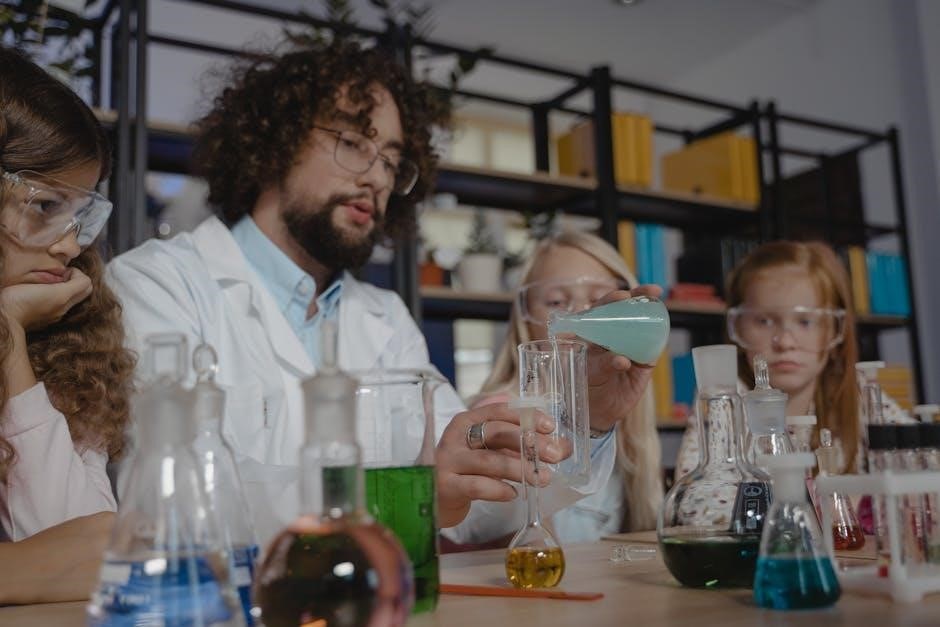
The Science Behind Cooking
Cooking is deeply rooted in chemistry, involving chemical reactions like digestion, combustion, and emulsification․ Ingredients’ properties and heat transform dishes, showcasing how chemistry enhances culinary skills and creativity․
3․1 Chemical Reactions in the Kitchen
Cooking is a chemistry lab where ingredients undergo transformative reactions․ Processes like the Maillard reaction (browning) and emulsification (mixing oil and water) are fundamental․ Heat, acids, and enzymes drive these changes, altering flavors, textures, and colors․ For instance, baking soda reacts with acids to leaven bread, while proteins coagulate when heated․ Understanding these reactions helps optimize recipes and prevent failures․ Chemical principles like pH levels and molecular interactions are key to achieving desired results․ Every dish is a chemical experiment, making cooking a practical application of chemistry․
3․2 The Role of Ingredients in Chemical Processes
Ingredients are the building blocks of chemical reactions in cooking․ Each component plays a specific role, such as acids reacting with bases or enzymes breaking down proteins․ For example, olive oil emulsifies with vinegar, while salt enhances flavor by altering chemical perceptions․ Ingredients like yeast ferment sugars, producing carbon dioxide for leavening․ Understanding their roles helps tailor recipes, balancing flavors and textures․ From the Perfect Lasagna to A-Pie-ogenesis, ingredients dictate chemical outcomes, making their selection and proportion crucial for success․ This chemical interplay transforms raw materials into culinary masterpieces, showcasing the science behind every dish․
3․3 Understanding Food Chemistry
Food chemistry reveals how ingredients interact during cooking, transforming raw materials into flavorful dishes․ Chemical reactions like the Maillard reaction enhance flavors and textures, while acids and bases balance tastes․ Ingredients act as reactants, catalysts, or stabilizers, influencing outcomes․ For instance, baking soda leavens bread, while yeast ferments dough․ Understanding these principles helps predict results, enabling precise adjustments․ From the Perfect Lasagna to A-Pie-ogenesis, food chemistry explains why recipes succeed or fail․ It empowers cooks to innovate, ensuring dishes are both delicious and scientifically sound․ This knowledge bridges cooking and science, making culinary experiments predictable and rewarding․

Safety Procedures in Chemical Cooking
Ensure safe handling of chemicals, use protective gear, and follow local regulations․ Adult supervision is crucial for risky experiments․ Always prioritize caution to avoid accidents․
4․1 Handling Chemicals Safely
Handling chemicals in cooking requires attention to safety․ Always wear protective gloves and eyewear to prevent exposure․ Use well-ventilated areas to avoid inhaling fumes․ Ensure all chemicals are stored properly and out of reach of children․ Dilute solutions when possible to minimize risks․ Never mix chemicals without understanding their reactions․ Follow instructions carefully and consult safety data sheets if available․ If an accident occurs, act quickly by flushing the area with water or seeking medical help․ Remember, safety is the foundation of enjoyable and successful chemical cooking experiments․
4․2 Essential Safety Equipment for Home Experiments
Essential safety equipment for home experiments includes goggles, gloves, and an apron to protect against splashes and spills․ A thermometer ensures accurate temperature control, while a first aid kit remains a crucial standby․ Keep a fire extinguisher nearby for emergencies․ Proper ventilation is key, so use a fume hood or well-ventilated space․ Store chemicals in labeled containers and maintain a clean workspace․ These tools help create a safe environment for exploring chemical recipes and experiments․ Always prioritize safety to enjoy a fun and educational cooking experience․
4․3 Local Safety Rules and Regulations
Adhering to local safety rules and regulations is crucial for chemical cooking experiments․ Familiarize yourself with community guidelines on handling chemicals and waste disposal․ Ensure proper ventilation and use protective gear as mandated by local safety standards․ Stay informed about specific regulations regarding chemical storage and usage in home settings․ Consulting local safety manuals or online resources can provide tailored guidance․ Always follow recommended safety protocols to ensure compliance and safety during experiments․ Remember, local rules may vary, so staying informed is key to a safe and enjoyable experience with chemical recipes․
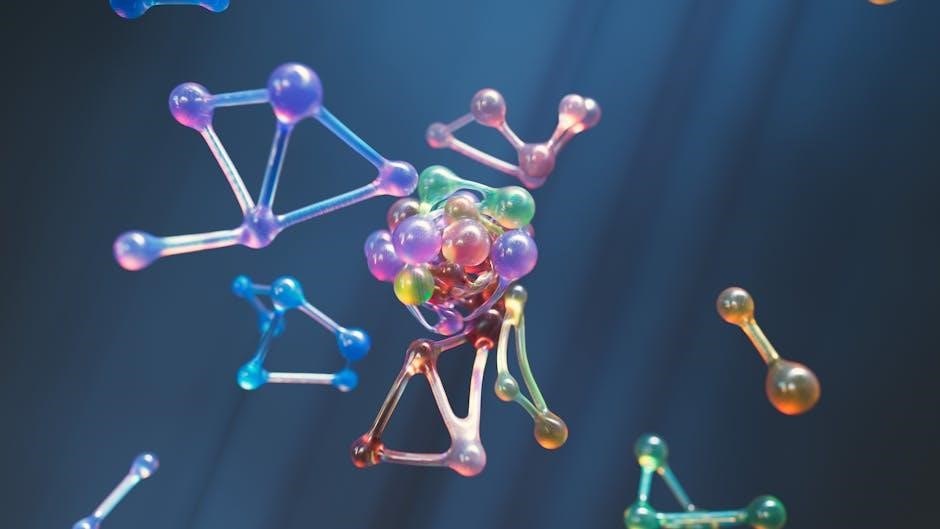
Experimental Recipes for Home
Discover fun and educational recipes that bring science to life in your kitchen․ From simple experiments to creative dishes, these recipes make learning chemistry delicious and engaging․
5․1 Simple Experiments with Everyday Ingredients
Transform your kitchen into a lab with simple experiments using everyday ingredients․ Learn how common items like flour, sugar, and olive oil undergo chemical changes․ Create crystals, homemade lava lamps, or fizzing reactions․ These fun, safe experiments teach fundamental chemistry concepts․ Perfect for families or beginners, they make science accessible and engaging․ Always follow safety guidelines, especially with children, and enjoy the thrill of discovery․ These experiments not only educate but also inspire creativity, showing how chemistry is part of daily life․ Start with easy recipes and watch your kitchen become a space for learning and delicious exploration․
5․2 Creating a Recipe Poster: A Fun Learning Activity
Engage in a creative learning experience by designing a recipe poster that combines chemistry with cuisine․ Illustrate the chemical reactions behind your dish, such as emulsification in mayonnaise or the Maillard reaction in baking․ Use icons, diagrams, and notes to explain the science․ This activity helps visualize how ingredients interact and transform during cooking․ It’s a great way to teach chemistry concepts while fostering creativity․ Students or enthusiasts can customize posters with colors, images, and fun facts, making it both educational and enjoyable․ This hands-on project turns cooking into a visual and interactive learning adventure, perfect for classrooms or home experiments․
5․3 Tips for Successful Kitchen Experiments
Ensure safety and success in your kitchen experiments by following key tips․ Always measure ingredients accurately, as ratios are crucial in chemical reactions․ Use proper laboratory-grade equipment, such as thermometers and glassware, to maintain precision․ Conduct experiments in a well-ventilated area and wear protective gear like goggles․ Adult supervision is essential for tasks involving heat or hazardous materials․ Clean your workspace regularly to prevent cross-contamination and accidents․ Stay patient and observant, as timing and temperature significantly impact outcomes․ Embrace creativity but follow instructions carefully to avoid failures․ Remember, learning from mistakes is part of the scientific process!

The Role of Chemistry in Everyday Cooking
Cooking is chemistry in action, where chemical reactions like emulsification, the Maillard reaction, and acid-base interactions transform ingredients into flavorful dishes, enhancing taste and texture․
6․1 Chemical Compositions in Food
Understanding the chemical compositions in food is essential for mastering culinary techniques․ Ingredients like proteins, fats, and carbohydrates undergo transformations during cooking, influenced by heat, pH, and chemical reactions․ For instance, the browning of meat (Maillard reaction) or the emulsification of sauces relies on specific molecular interactions․ Even simple recipes, like those in “Lessons in Chemistry Recipes PDF”, highlight how chemical properties of ingredients determine their behavior․ By grasping these principles, cooks can predict outcomes, enhance flavors, and create balanced dishes․ This scientific approach elevates cooking from art to a precise, chemistry-driven process․
6․2 The Chemistry of Baking and Cooking
The chemistry of baking and cooking revolves around how ingredients interact during preparation․ Baking relies on precise chemical reactions, such as the release of carbon dioxide from leavening agents, while cooking involves thermal transformations of proteins and starches․ Techniques like emulsification in sauces or the caramelization of sugars are rooted in chemical principles․ In “Lessons in Chemistry Recipes PDF”, these processes are explored through recipes like A-Pie-ogenesis, demonstrating how understanding chemical reactions can elevate culinary results․ This blend of art and science transforms ordinary ingredients into extraordinary dishes, making cooking a fascinating application of chemistry․
6․3 How Chemical Reactions Affect Taste and Texture
Chemical reactions in cooking significantly influence the taste and texture of dishes․ Processes like caramelization, the Maillard reaction, and emulsification transform ingredients, enhancing flavors and creating appealing textures․ For instance, the browning of meat or bread is a chemical reaction that intensifies flavor․ Similarly, the structure of baked goods relies on reactions between acids, bases, and heat․ In “Lessons in Chemistry Recipes PDF”, recipes like A-Pie-ogenesis demonstrate how these reactions are harnessed to achieve perfect crusts and balanced flavors․ Understanding these principles allows for experimentation, ensuring dishes are both delicious and visually appealing․ Chemistry is the backbone of culinary success․
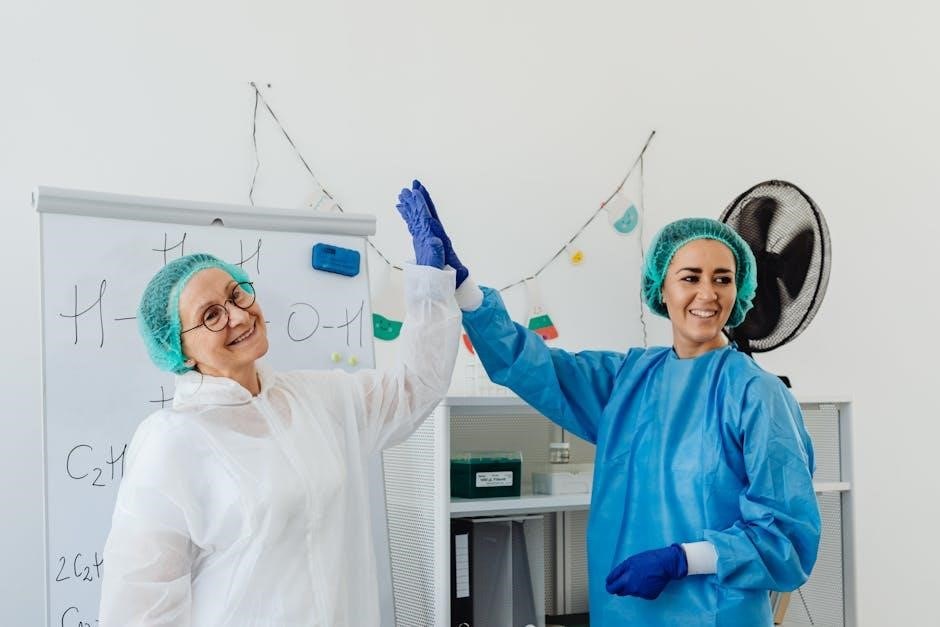
Educational Applications of Chemical Recipes
Chemical recipes offer a hands-on approach to teaching chemistry, making complex concepts engaging․ Students create recipe posters, exploring chemical reactions and food composition, fostering STEM learning through culinary experiments․
7․1 Teaching Chemistry Through Cooking
Cooking serves as an engaging tool for teaching chemistry, transforming complex concepts into relatable experiences․ By exploring recipes, students observe chemical reactions firsthand, such as emulsions in mayonnaise or Maillard reactions in baking․ This hands-on approach simplifies abstract ideas, fostering a deeper understanding of chemistry principles․ Experiments with everyday ingredients make learning interactive and fun, encouraging curiosity and creativity․ Through this method, students develop problem-solving skills and appreciate the science behind food preparation, making chemistry accessible and enjoyable in a real-world context․
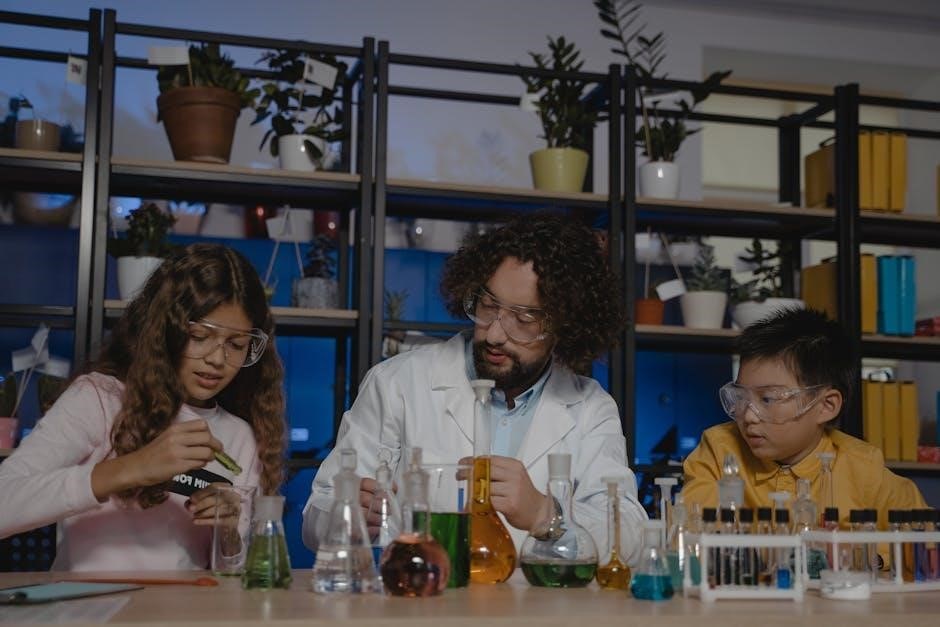
7․2 Integrating Chemical Recipes into School Curriculum
Integrating chemical recipes into school curricula offers a dynamic way to teach scientific principles; By incorporating recipes from “Lessons in Chemistry Recipes PDF”, educators can align cooking experiments with academic standards, making chemistry relatable and fun․ Students engage in hands-on activities, observing chemical reactions and understanding molecular interactions․ This approach fosters critical thinking and teamwork while connecting science to daily life․ Additionally, it encourages interdisciplinary learning, blending chemistry with culinary arts․ Schools can adapt these recipes to various grade levels, ensuring a comprehensive and engaging STEM education experience that prepares students for future scientific exploration and experimentation․
7․3 Encouraging STEM Learning with Food Experiments
Food experiments are a delicious way to encourage STEM learning, making complex concepts accessible and fun; Using recipes from “Lessons in Chemistry Recipes PDF”, students can explore chemical reactions, such as the Maillard reaction in cooking or emulsification in baking․ These hands-on activities teach scientific principles like molecular interactions and chemical changes․ By experimenting with ingredients, students develop problem-solving skills and curiosity․ This approach also highlights the importance of safety and measurement in chemistry․ Making STEM engaging through food fosters a deeper appreciation for science and its role in everyday life, inspiring future scientists and innovators․

Modern Chemical Recipes and Innovations
Modern chemical recipes integrate advanced techniques like spherification and foamification, inspired by molecular gastronomy․ These innovations transform traditional cooking into a scientific art, advancing culinary creativity and precision․
8․1 Molecular Gastronomy: A Modern Twist on Cooking
Molecular gastronomy revolutionizes cooking by applying scientific principles to create innovative dishes․ Techniques like spherification and foamification transform ingredients into unique textures, enhancing flavor and presentation․ This culinary science blends chemistry with creativity, using tools like sodium alginate and liquid nitrogen․ Inspired by shows like Lessons in Chemistry, home cooks explore these methods․ With precise measurements and chemical reactions, molecular gastronomy turns cooking into an experimental art form․ It challenges traditional recipes, fostering a deeper understanding of food chemistry and encouraging chefs to innovate․ This modern approach makes cooking both educational and visually stunning․
8․2 Advanced Chemical Techniques in Recipe Development
Advanced chemical techniques in recipe development involve precision and innovation․ Methods like precision temperature control, ingredient manipulation, and chemical reactions enhance flavor and texture․ Techniques such as gelification, emulsification, and dehydration transform traditional dishes into modern culinary masterpieces․ These approaches rely on understanding chemical properties of ingredients, enabling chefs to experiment with novel combinations․ Tools like ultrasonic blenders and vacuum sealers further expand creative possibilities․ By applying scientific principles, cooks can create dishes with unique aesthetics and tastes․ This fusion of chemistry and cooking inspires experimentation, making recipe development both an art and a science, appealing to chefs and enthusiasts alike․
8․3 The Future of Food Chemistry in Home Cooking
The future of food chemistry in home cooking lies in innovative techniques and accessible tools․ Molecular gastronomy, once reserved for professionals, is becoming a hobby for enthusiasts․ Home cooks are embracing science-driven methods like spherification and foamification․ With advancements in kitchen technology, such as sous vide machines and precision cookers, experimenting with chemical reactions is easier than ever․ Sustainable practices, like reducing food waste through chemical transformations, are gaining traction․ Education and online communities are democratizing food chemistry, encouraging creativity and experimentation․ As knowledge grows, home cooking will become more precise, creative, and scientifically inspired, blurring the line between chef and chemist․
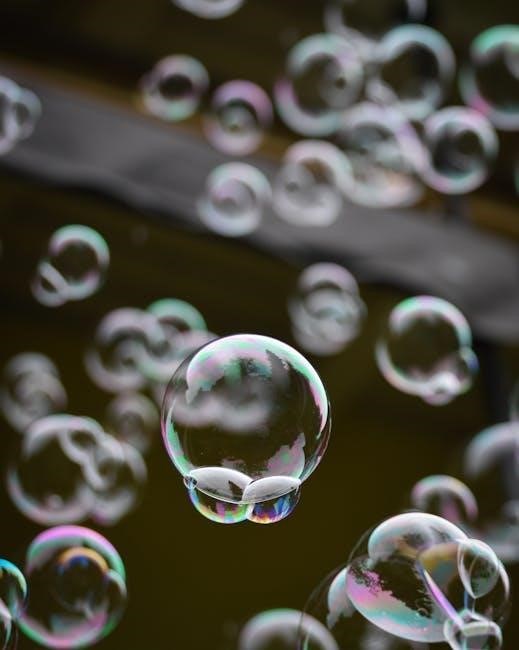
Resources for Chemical Recipes
Access Lessons in Chemistry Recipes PDF for detailed guides, or explore books like The Chemist’s Cookbook and online communities for inspiration and scientific insights․
9․1 Where to Find Reliable Chemical Recipe PDFs
Discover reliable chemical recipe PDFs through trusted sources like Apple TV’s Lessons in Chemistry and educational platforms offering detailed guides․ The Chemist’s Cookbook provides comprehensive formulas, while online communities share experiment-based recipes․ Ensure safety by following instructions and local regulations when handling chemicals․ These resources blend culinary creativity with scientific accuracy, perfect for enthusiasts exploring food chemistry․
9․2 Recommended Books and Guides on Food Chemistry
For a deeper understanding of food chemistry, explore books like “The Chemist’s Cookbook” and “Food Chemistry: Principles and Applications”․ These guides provide detailed insights into chemical compositions, reactions, and practical kitchen applications․ They are ideal for both enthusiasts and educators, offering a blend of scientific theory and culinary creativity․ Additionally, resources like “Molecular Gastronomy: A Scientific Approach to Cooking” and “The Science of Cooking” are excellent for exploring advanced techniques․ These books are essential for anyone looking to enhance their cooking skills and understanding of chemical processes in the kitchen, complementing the “Lessons in Chemistry Recipes PDF” perfectly․
9․3 Online Communities for Chemical Cooking Enthusiasts
Join online communities like Reddit’s r/CookingScience or r/Chemistry to connect with fellow enthusiasts․ These forums share recipes, experiments, and tips, fostering creativity and learning․ Facebook groups dedicated to molecular gastronomy and food chemistry also offer valuable insights․ Websites like Chemical Cooking and Cooking Chemistry Forums provide detailed guides and discussions․ Engage with experts and hobbyists, sharing your own experiments and gaining inspiration․ These platforms are perfect for exploring the scientific side of cooking and staying updated on the latest trends in chemical recipes and food science․
“Lessons in Chemistry Recipes PDF” beautifully blends science and culinary art, inspiring creativity in the kitchen․ From the Apple TV series to home experiments, it sparks curiosity and learning, encouraging future exploration and innovation in cooking and chemistry․
10․1 Recap of Key Concepts
The “Lessons in Chemistry Recipes PDF” explores the convergence of chemistry and cooking, offering a unique perspective on culinary science․ It introduces iconic recipes like The Perfect Lasagna and A-Pie-ogenesis, emphasizing chemical reactions, ingredient interactions, and safety protocols․ By integrating scientific principles into everyday cooking, the guide highlights the importance of experimentation and creativity․ It also underscores the educational value of using food chemistry to teach STEM concepts․ This resource provides a comprehensive foundation for understanding how chemistry shapes cooking, making it a valuable tool for both home cooks and aspiring scientists․
10․2 The Future of Chemistry in Cooking
The future of chemistry in cooking is poised for innovation, with molecular gastronomy and advanced techniques gaining prominence․ Home cooks and professional chefs alike are embracing scientific methods to create unique, flavorful dishes․ The integration of technology, such as precision temperature control and sous vide, is transforming traditional recipes․ Educational resources like “Lessons in Chemistry Recipes PDF” are inspiring a new generation to experiment with food science․ Online communities and workshops are fostering collaboration, making complex chemical techniques accessible․ As sustainability becomes a priority, chemistry will play a key role in developing eco-friendly cooking practices, ensuring a bright and creative future for culinary arts․
10․3 Encouraging Further Exploration and Experimentation
Embrace the joy of culinary experimentation by exploring new recipes and techniques․ Encourage curiosity in the kitchen, where chemistry meets creativity․ Don’t be discouraged by failures—they’re opportunities to learn․ Dive into resources like “Lessons in Chemistry Recipes PDF” for inspiration and guidance․ Join online communities to share ideas and discover innovative approaches․ Engage in hands-on experiments, ensuring safety with proper equipment and guidelines․ Foster a mindset of continuous learning, blending science with culinary art․ The future of cooking lies in this intersection, where creativity and chemistry collide to create something extraordinary․ Keep experimenting and savor the science behind every dish․